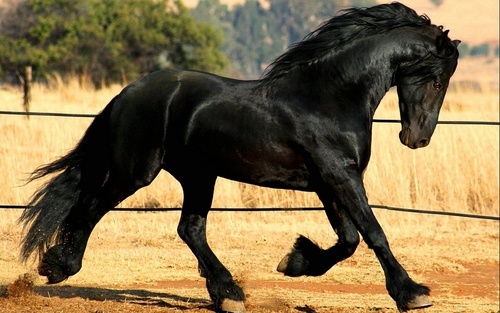
The “magnus equus” or “great horse” of the Middle Ages in Europe that helped give heavy cavalry its battlefield preeminence. The name derived from the Anglo-Norman “destrer,” which in turn came from the rough Latin “dexterius,” or “dexterarius,” meaning “right-handed.” This large breed was best known across Europe by the French “destrier.” First bred in the 12th century, it became the main battle horse of every full-fledged, wealthier knight. It was always a stallion, highly spirited, and trained to charge straight toward the enemy. It was led to the fight by hand rather than ridden, being mounted only in training, perhaps in tournaments, or for real battle. It was never used for mere transport. The great destriers of the 14th century were huge horses by the standard of the day; probably 16 hands and 1,300 pounds, not the 18 hands sometimes cited, but still 3-4 hands bigger than the average medieval horse. At first these great horses were clad in padded cloth and gaily decorated with personal coats-of-arms. As missile power increased they were given mail trappers. Later, they wore plate armor on their head (chanfron) and chest (peytral). A knight in full armor needed assistance of his attendants to mount a great warhorse (leading to the expression that well-captured a common knightly smugness and assumed superiority, “mount one’s high horse”). These large chargers were hugely expensive, costing from 5 to 35 times the price of a hackney, a horse type used solely for transport of men or goods. This meant they were ridden almost exclusively by the great nobles and wealthier knights, but not by the average man-at-arms. They were taken to the Levant on the Crusades, where they sometimes succeeded in “shock” defeats of Arab and Turkic armies. But they could be easily blown under heat, which exposed them to Muslim tactics of closing after a failed Crusader charge to fight at close quarters with bows, lance, or sword from fleeter and more maneuverable Arabian mounts.
Equestrian warfare by mounted, armored men is closely associated with the history of Medieval Europe. Heavy cavalry began its rise to martial preeminence under the Carolingians in France in the 8th-9th centuries. Thereafter, cavalry rose to predominance not just militarily but as a full horse culture: warhorse and rider were central to feudalism, chivalry, and knighthood. By the 11th century, heavy horse was overpowering in nearly every European battle. Up to the 15th century, knights of the first rank rode to the fight with at least three types of specialized warhorses. Most important was the “dexterarius,” better known as the destrier or main battle horse. It was led to combat by hand and ridden only in tournaments or on the battlefield. Like the knight, it too was usually clad in cloth and some armor, and decorated with a coat of arms. In the 12th-13th centuries destriers were clad in heavy padded quilts (“trappers”). By the 14th century a destrier wore mail and plate in combination, with a chanfron protecting his head and a peytral covering his chest (all destriers were stallions). Controversy lingers over the size of medieval chargers. Andrew Ayton, the expert historian of equine warfare, suggests the typical destrier was “of the order of 14 to 15 hands in height-not a large animal by modern standards.” That assessment needs this context: people, too, were much smaller on average than today. The overall effect and impression made by a powerful destrier was therefore still that it was a huge battle horse, first in its class and “heavy” by comparison to the normal nags or hackneys of town or country life. And like its rider, the appearance of girth and hitting power was enhanced in the charge by its shell of armor and flowing and flapping cloth. The second horse in a knight’s stable was a palfrey. It carried the knight on the road to battle, thereby keeping the great destrier fresh. Finally, the knight might have one or more pack horses to help his page or squire carry armor, weapons, and personal comforts. The number of warhorses owned, along with the richness and amount of armor worn, often determined if ordinary soldiers might aspire to gain the status of men-at-arms.